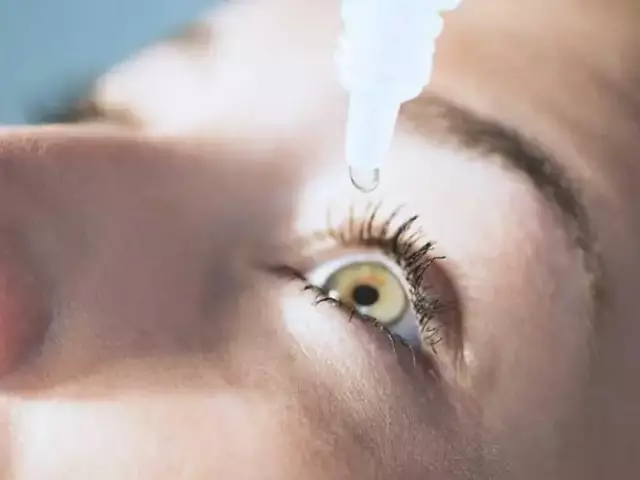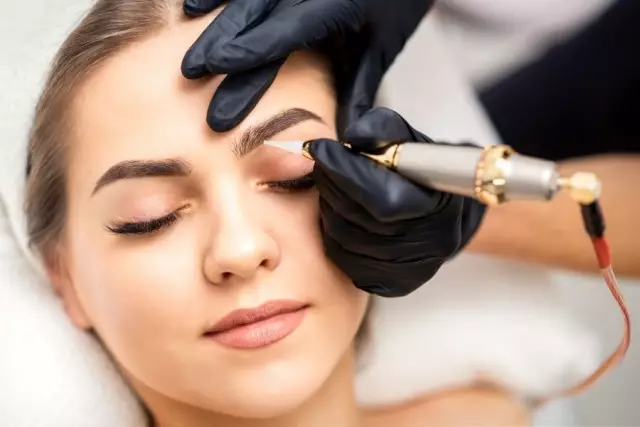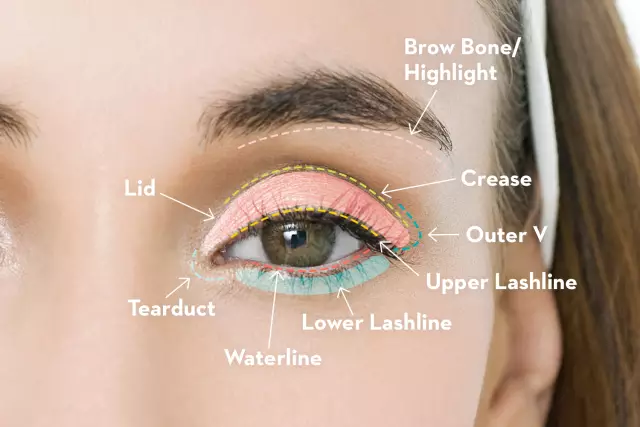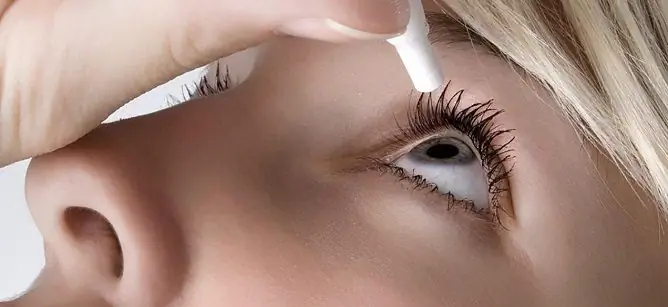- Author Rachel Wainwright [email protected].
- Public 2023-12-15 07:39.
- Last modified 2025-11-02 20:14.
Phenicamide
Fenikamide: instructions for use and reviews
- 1. Release form and composition
- 2. Pharmacological properties
- 3. Indications for use
- 4. Contraindications
- 5. Method of application and dosage
- 6. Side effects
- 7. Overdose
- 8. Special instructions
- 9. Application during pregnancy and lactation
- 10. Use in childhood
- 11. Use in the elderly
- 12. Drug interactions
- 13. Analogs
- 14. Terms and conditions of storage
- 15. Terms of dispensing from pharmacies
- 16. Reviews
- 17. Price in pharmacies
Latin name: Phenycamid
ATX code: S01FA56
Active ingredient: tropicamide (Tropicamide); phenylephrine (Phenylephrine)
Manufacturer: LLC "Grotex" (Russia)
Description and photo update: 2020-05-03
Prices in pharmacies: from 600 rubles.
Buy

Fenikamide is a combined drug containing an α-adrenergic agonist and an m-anticholinergic agent, the potentiated action of which on different muscle groups allows achieving maximum mydriasis for unhindered diagnosis of ophthalmic diseases.
Release form and composition
The drug is produced in the form of eye drops: transparent, colorless or from yellow to brown-yellow liquid (5 or 10 ml each in a multi-dose bottle with a dropper and a cap with a first opening control / in a multi-dose bottle-dropper complete with a screw cap and a stopper - dropper or 10 ml in a multi-dose vial made of polyethylene terephthalate with a plastic dropper, sealed with a lid with control of the first opening; 1 bottle is sealed in a foil bag; in a cardboard box, 1 bottle in a foil film bag or without it and instructions for use of Fenicamide) …
1 ml of eye drops contain:
- active substances: phenylephrine hydrochloride - 50 mg; tropicamide - 8 mg;
- additional components: sodium hydrogen phosphate dihydrate, benzalkonium chloride, sodium chloride, hydrochloric acid solution 1M or sodium hydroxide solution 1M, sodium dihydrogen phosphate monohydrate, disodium edetate dihydrate (Trilon B), water for injection.
Pharmacological properties
Pharmacodynamics
Phenicamide, due to the content in the composition of two active components - a non-selective m-cholinergic blocker (tropicamide) and an α-adrenergic agonist (phenylephrine), which have a complementary effect, causes the rapid achievement of maximum action, as well as prolonged and persistent pupil dilation (mydriasis).
Tropicamide
Tropicamide blocks the m-cholinergic receptors of the sphincter of the pupil and the ciliary muscle, leading to short-term mydriasis and accommodation paralysis. Causes a slight increase in intraocular pressure (IOP).
Against the background of the use of tropicamide, the development of mydriasis is noted after 5-10 minutes and reaches its maximum, which lasts for 1 hour, in the range from 20 to 45 minutes. The pupil width is normalized after 6 hours.
Phenylephrine
Phenylephrine belongs to non-selective α-adrenergic agonists. After instillation into the eye, it leads to dilatation of the pupil, improved outflow of intraocular fluid and narrowing of the vessels of the conjunctiva.
Phenylephrine is characterized by a pronounced stimulating effect on postsynaptic α-adrenergic receptors, and very weak - on β1-adrenergic receptors. Demonstrates a vasoconstrictor effect similar to the effect of norepinephrine (norepinephrine), while practically does not have inotropic and chronotropic effects on the heart. The vasopressor activity of the substance is less pronounced in comparison with norepinephrine, however, it is more prolonged.
After administration, phenylephrine contracts the pupil dilator and the smooth muscle of the conjunctival arterioles, which causes the diaphragm opening in the opaque iris to expand. With a single instillation, mydriasis is fixed after 10-60 minutes and lasts 4-6 hours. Pupil dilatation caused by phenylephrine does not cause the development of cycloplegia.
Phenylephrine complements the effect of tropicamide, since their mechanisms of action are different. Introduction in this combination weakens or suppresses the ability of the latter to increase IOP.
Pharmacokinetics
Both active substances included in Phenicamide easily penetrate the tissues of the eye.
Tropicamide is rapidly absorbed into the systemic circulation. Using a modified radioreceptor analysis, it was found that in plasma the lower limit of determination of this substance is less than 240 ng / ml, the range of determination is 240-10 ng / ml. The average plasma maximum concentration (C max) of tropicamide at the 5th minute after instillation corresponded to 2.8 ± 1.7 ng / ml. Its C max in plasma at the 60th minute was 0.46 ± 0.51 ng / ml, at the 120th minute it was less than 240 ng / ml.
After topical application, C max of phenylephrine in plasma is observed after 10-20 minutes. The active substance is excreted by the kidneys unchanged (less than 20%) or in the form of inactive metabolites.
Indications for use
Fenicamide is recommended for use as a mydriatic agent in the following cases:
- carrying out diagnostic ophthalmic procedures;
- preparation for surgical and laser operations.
Contraindications
Absolute:
- mixed glaucoma;
- angle-closure and narrow-angle glaucoma;
- diseases of the cardiovascular system (including angina pectoris, arrhythmia, hypertensive crisis, coronary sclerosis);
- thyrotoxicosis;
- renal porphyria;
- type 1 diabetes mellitus;
- age up to 18 years;
- pregnancy, lactation period;
- simultaneous use with monoamine oxidase inhibitors (MAO), as well as a period of 3 weeks after their cancellation (the threat of systemic adrenergic effects is aggravated);
- hypersensitivity to any component of the drug.
Relative (use Fenicamide eye drops for these diseases / conditions must be under medical supervision):
- cerebrovascular diseases;
- type 2 diabetes mellitus;
- conditions after surgery (due to reduced healing of the conjunctiva);
- elderly age.
Fenikamide, instructions for use: method and dosage
Eye drops Fenicamide is used by instillation into the conjunctival cavity.
In order to dilate the pupil during surgical and diagnostic ophthalmic interventions, 1-2 drops of the drug are instilled 15-30 minutes before the procedure (operation).
Side effects
- systemic side effects: dry skin, pallor / redness of the skin, dry mouth, contact dermatitis causing constipation, decreased gastrointestinal (GI) tract tone and peristalsis, difficulty urinating, frequent urge to urinate, palpitations, decreased blood pressure (BP), headache, fainting, arrhythmia, tachycardia, bradycardia, pulmonary embolism, ventricular occlusion of the coronary arteries, muscle rigidity, central nervous system (CNS) disorders; sometimes dizziness and vomiting; in elderly people with lesions of the cardiovascular system - ventricular arrhythmias, myocardial infarction;
- local reactions: increased IOP, transient burning sensation, pain in the eye, temporary decrease in vision, photophobia, lacrimation, pain in the superciliary arches, release of pigment into aqueous humor with a temporary increase in IOP, conjunctival hyperemia, keratitis, blocking of the anterior chamber angle (with narrowing of the angle), allergic reactions; rarely - reactive miosis the next day after instillation (repeated instillation of Fenicamide during this period may demonstrate less pronounced mydriasis than the day before; this reaction is more often observed in older people).
Overdose
There are no reports of topical overdose of tropicamide and phenylephrine.
In case of unintentional intake of Fenicamide inside, symptoms of an overdose may be dry mucous membranes and skin, hyperthermia, mydriasis, tachycardia, agitation, convulsions, respiratory depression, coma.
In this condition, gastric lavage and activated carbon are prescribed. Physostigmine is used as an antidote at 0.03 mg / kg intravenously (iv) slowly, benzodiazepines, in order to eliminate hyperthermia - cold compresses. To block the systemic effects of phenylephrine, intravenous α-adrenergic blockers are administered, for example, phentolamine 5-10 mg, if necessary, the injection is repeated.
special instructions
Fenicamide is recommended to be injected into the lower conjunctival sac. To reduce the risk of undesirable systemic effects after instillation, it is recommended to gently press with a finger at the inner corner of the eye on the projection area of the lacrimal sacs for 1-2 minutes.
As a result of a significant contraction of the pupil dilator muscle 30-45 minutes after the introduction of drops, pigment particles from the pigment layer of the iris can be detected in the moisture of the anterior chamber of the eye. It is necessary to differentiate a suspension from the chamber moisture with manifestations of anterior uveitis or with the penetration of blood cells into the chamber moisture.
Phenicamide contains benzalkonium chloride as a preservative, which can provoke the occurrence of punctate keratopathy and / or toxic ulcerative keratopathy. As a result, against the background of frequent (prolonged) use of the drug in persons with dry eye syndrome or damage to the cornea, careful monitoring is required. Since it is known that benzalkonium chloride can lead to discoloration of soft contact lenses, they must be removed before instillation and put on again no earlier than 15 minutes after its completion.
Drugs related to cycloplegics can increase IOP and cause angle-closure glaucoma in predisposed patients, which should be taken into account, and a thorough assessment of the benefits / harms of therapy should be carried out before starting treatment.
It has been established that tropicamide is capable of inducing psychosis.
Influence on the ability to drive vehicles and complex mechanisms
Since Fenicamide can lead to a decrease in visual acuity as a result of changes in accommodation and pupil width, it is not recommended to use drops if it is necessary to drive vehicles and control other complex moving mechanisms.
Application during pregnancy and lactation
The appointment of Fenikamide for pregnant and lactating women is contraindicated.
Pediatric use
Fenicamide is contraindicated in children and adolescents under 18 years of age.
Use in the elderly
Elderly patients, due to the aggravation of the risk of myocardial infarction and ventricular arrhythmias against the background of diseases of the cardiovascular system, should use Fenicamide with extreme caution.
Drug interactions
- amantadine, quinidine, tricyclic antidepressants, antihistamines, phenothiazines: the likelihood of systemic adverse reactions of tropicamide increases;
- adrenomimetics: potentiate the effect of tropicamide;
- atropine: enhances the mydriatic effect of phenylephrine;
- β-blockers: the vasoconstrictor effect of phenylephrine increases as a result of the suppression of vasodilation by these means; the threat of a sharp increase in blood pressure is aggravated;
- m-cholinomimetics: the effect of tropicamide decreases;
- tricyclic antidepressants, m-anticholinergics, guanethidine, propranolol, methyldopa: increase the vasoconstrictor effect of α-adrenergic agonists;
- inhalation drugs for general anesthesia: the threat of oppression of cardiovascular activity increases;
- guanethidine, monoamine reuptake inhibitors: the risk of developing a hypertensive crisis is aggravated when phenylephrine is combined with these drugs or any other adrenergic blocker;
- local anesthetics: with preliminary instillation of these funds, it is possible to increase the systemic absorption of active substances and prolong mydriasis.
Analogs
Analogs of Phenicamide are Atropine, Midrimax, Irifrin, Appamid Plus, Midriacil, Cyclomed, Mezaton, etc.
Terms and conditions of storage
Store out of the reach of children at a temperature not exceeding 25 ° C.
Shelf life is 2 years.
After the first opening of the multi-dose vial, the drops can be used for 1 month.
Terms of dispensing from pharmacies
Dispensed by prescription.
Reviews about Fenikamide
Currently, on specialized sites there are no reviews of Fenicamide from patients, on the basis of which it would be possible to objectively assess the effectiveness and disadvantages of the drug.
Experts recommend additionally using Fenicamide as part of the complex treatment of accommodation disorders and in the treatment of inflammatory diseases to prevent the development of posterior synechia.
Price for Phenicamide in pharmacies
The price of Phenicamide, in the form of eye drops, can be 600 rubles. for a dropper bottle with a volume of 10 ml.
Fenicamide: prices in online pharmacies
|
Drug name Price Pharmacy |
|
Fenicamide eye drops 10 ml 1 pc. RUB 600 Buy |
|
Fenicamide eye drops 10 ml RUB 608 Buy |

Maria Kulkes Medical journalist About the author
Education: First Moscow State Medical University named after I. M. Sechenov, specialty "General Medicine".
Information about the drug is generalized, provided for informational purposes only and does not replace the official instructions. Self-medication is hazardous to health!






